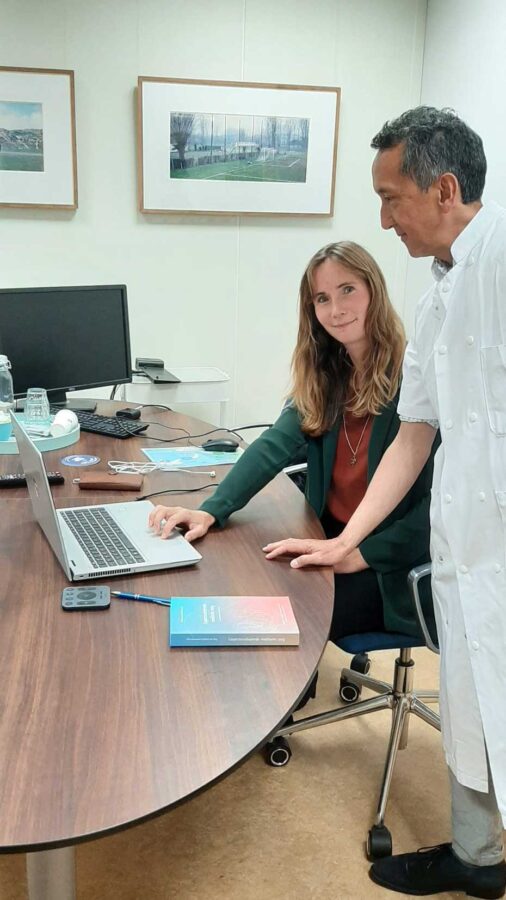Improving Python Skills to Enable Evidence-Based Healthcare Delivery
Recent advancements in artificial intelligence (AI) have enabled new models of evidence-based healthcare delivery. Feline Spijkerboer, a clinical data scientist at Leiden University Medical Center (LUMC), wanted to help her hospital bridge the gap between AI technology and clinical practice even more, so she completed Xebia’s Advanced Data Science with Python training course.
Value-Based Healthcare and AI
As an investment in AI innovation, Leiden University Medical Center (LUMC) established a value-based healthcare AI team. Value-based healthcare is a healthcare delivery model that improves patients’ health in an evidence-based way. Doctors from all departments at LUMC could approach this new team with various data-science-oriented queries.

However, it soon became clear that the eight-person team could not handle the sheer quantity of queries, let alone exploit its innovation potential. So, to accelerate AI development and research, LUMC expanded the group into a knowledge and expertise center with an overarching platform. This Clinical Artificial Intelligence and Research Lab (CAIRELab) now brings all AI activities at LUMC together.
“Many of our people find it difficult to fully understand how AI works,” explained Spijkerboer, “Nevertheless, general data awareness within LUMC is growing steadily. And with the implementation and development of a central data platform, we’ll be able to improve our patients’ health and help them live healthier lives using data science.”
The CAIRELab will go fully live once Spijkerboer and her team make all the necessary moderations, iterations, and compliance adjustments to the software. But that might take a few more years. Since patient care goes arm-in-arm with time pressure, the software’s “user-friendliness” is crucial.
“Combining our knowledge and expertise is important. The pace of AI developments is ever-increasing. There are many legal, ethical, and technical hurdles to take in every AI project. Taking utmost care is extremely important, but speed is also of the essence because we are dealing with real patients. That is why, in the CAIRElab, we work with the healthcare workers to develop practical AI solutions, that support medical care and put doctors in control.”
The Box
One promising project or “user case” that falls under CAIRElab’s purview is The Box. The Box contains a scale, blood pressure and saturation meter, and an ECG heart-imaging device. A patient who has survived a heart attack is given the box of measuring equipment to use at home after surgery. The values are sent to the ward daily, allowing the nursing staff to monitor the patient remotely. If the values drop below the acceptable range, the patient must return to the hospital.
LUMC has already given The Box to 250 patients, which increased the workload of the nurses and cardiologists even further. So one of Spijkerboer’s AI team members wrote a predictive model that prioritized patients according to the measured values. Early test results were extremely positive, indicating the solution could go live quite soon.
Better Predictions Thanks to More Efficient Coding
As a clinical data scientist, Spijkerboer is familiar with machine learning, but she wanted to learn to code even more efficiently and increase the quality of her predictive models. For this reason, she completed GoDataDriven’s virtual Advanced Data Science with Python Training course.
The two-day course covers Data Science, Machine Learning, and advanced Python skills and includes best practices, models, code, algorithms, and a framework for the improvement of projects.
“It was an intensive training course,” described Spijkerboer, “especially since it was digital. It was a little less interactive than on-site training, but the limited group size made it easy to ask questions, and the pace was nice and easy to follow.”
According to Spijkerboer, the training added more value by using clearly structured notebooks. “Even after the course, it’s a clear reference of practical examples and recommendations,” she said.
“The most valuable thing for me was learning how to code more efficiently,” Spijkerboer added, “I achieved my learning goal and now know how to make code more readable and structured. My CAIRELab colleagues could also benefit greatly from this training, especially those in the field of data cleaning and pre-processing.”
Spijkerboer also praised the training for its accessibility.
“It was very easy to ask questions and get answers, both during and after the course. If something comes up as I am applying my new Python knowledge at work at LUMC, it’s a great feeling to know I can just send a message, and a Xebia trainer will help me.”
Are you interested in an Advanced Data Science with Python training course at GoDataDriven? You can find out more about it here: Python data science





